
Back to Sidestreet Bannerworks
May 2000
Steam trams in 1:22.5 scale
by Marc Horovitz
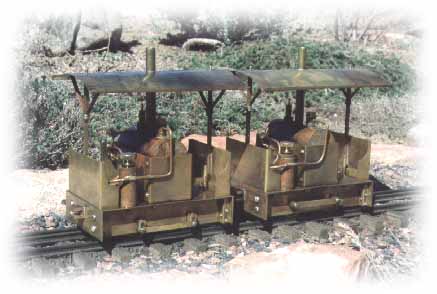
When my oldest daughter, Dori, was 12, she decided she wanted to build a live-steam locomotive from scratch. She was a determined child, so I agreed to design a simple locomotive. I decided to build one alongside her, to show her what to do, but she had to do all of her own work. This included learning how to use precision measuring instruments, doing her own math, and learning how to use a lathe and the necessary hand tools.
The agreement was that we would build our engine in phases. If she got tired of the project, she could quit, but only at the end of whichever phase we were in at the time.
The first section to be complete was the actual steam motor. This we were able to operate with a tire pump. Dori took it to school for show and tell, but I suspect the kids had no idea what they were looking at.
Work progressed steadily and enthusiasm remained high. One of the final major jobs was making the boiler. The parts were cut out of copper and silver-soldered together. Dori and I helped one another do this two-person job. After one or two reheats, we both had steam-tight boilers.
Once the chasses were complete, we put everything together for the first steam test. Up until now, I had only hoped it would work. This was the moment of truth. Dori got hers together first, late one spring evening, and we went out to the track to test it. She filled the lubricator with steam oil, the boiler with distilled water, and the fuel tank with alcohol. She lit the fire and we waited. After six or seven minutes, the safety valve began to sputter. Dori was a little leery of the thing, so I gave the flywheel a flip, and the engine was off. Performance far exceeded expectations, and it ran for a good long time. I quickly finished mine up and it also passed the test.
After this came the tedious work of making the cosmetic body parts. A lot of this was done with hand tools and it was at this point that Dori's interest began to flag. However, the National Garden Railway Convention (that year in Washington DC) was coming up, and we discussed the possibility of running our engines there together. This lit the fire again, and we finished up the project, each of us completing a tiny, functioning live-steam locomotive. And we did run them at the convention that year. Dori received a lot of praise from the other live steamers in attendance, which made the entire project worthwhile.
| Specifications | |
| Builders | Dora and Marc Horovitz |
| Date built | 1992 |
| Gauge | 45mm (non regaugeable) |
| Boiler | Silver-soldered pot |
| Fuel | Alcohol |
| No. of wicks | 1 |
| Cylinder | One single-acting oscillator |
| Drive | 17:1 gear drive to axle |
| Fittings | Safety valve, displacement lubricator |
| Duration | Approximately 30 minutes |
| Dimensions | Length: 5.125", width: 3.25", height: 6.5" over the stack |
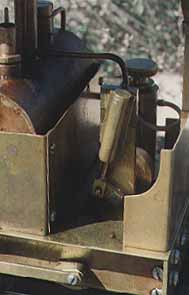
The cylinder is made from a length on 1/4"-diameter K&S brass tubing and the piston was turned on the lathe to fit. The piston rod and big end are all made of brass, as is the crank, flywheel axle, and flywheel. The flywheel is attached to the axle via a set screw.
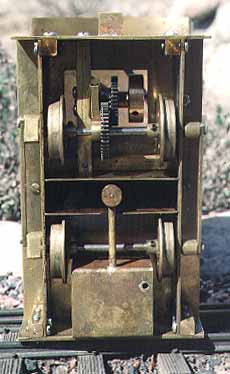
Gears from an old gear-head motor were used for the gear train. The final gearing (double-reduction) is 17:1 to the driven axle. The other axle is driven via conventional side rods.
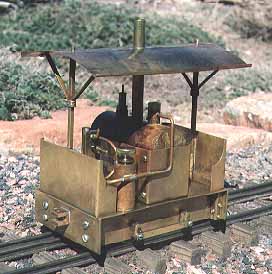
The steam line exits the boiler and travels through the lubricator, picking up oil for the cylinder. There is no throttle. The locomotive runs at a sedate speed under full power.
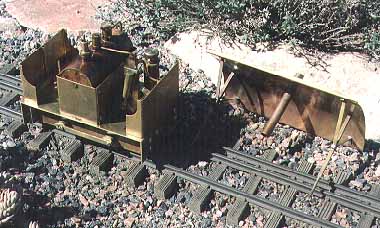
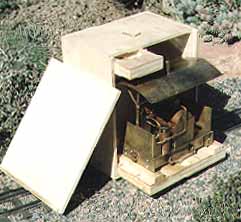
To fill the boiler, lubricator, and fuel tank, the roof and its supports can be lifted off the engine itself. The exhaust line is piped to the stub of the smokestack. When the superstructure is in place, exhaust steam comes out the stack, along with condensate and oil, making quite a mess of the roof.
For my engine, I made a little box. The locomotive fits on a wooden tray that slides into the box. Fittings on the tray and in the box hold the loco securely in place, protecting it from shifting. The drawer in the upper left corner of the box holds things like coupler links and pins and other small bits. The large wooden panel is a slide-in door.
Back to Sidestreet Bannerworks
This page and its contents Copyright Sidestreet Bannerworks, 2000